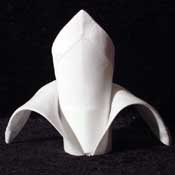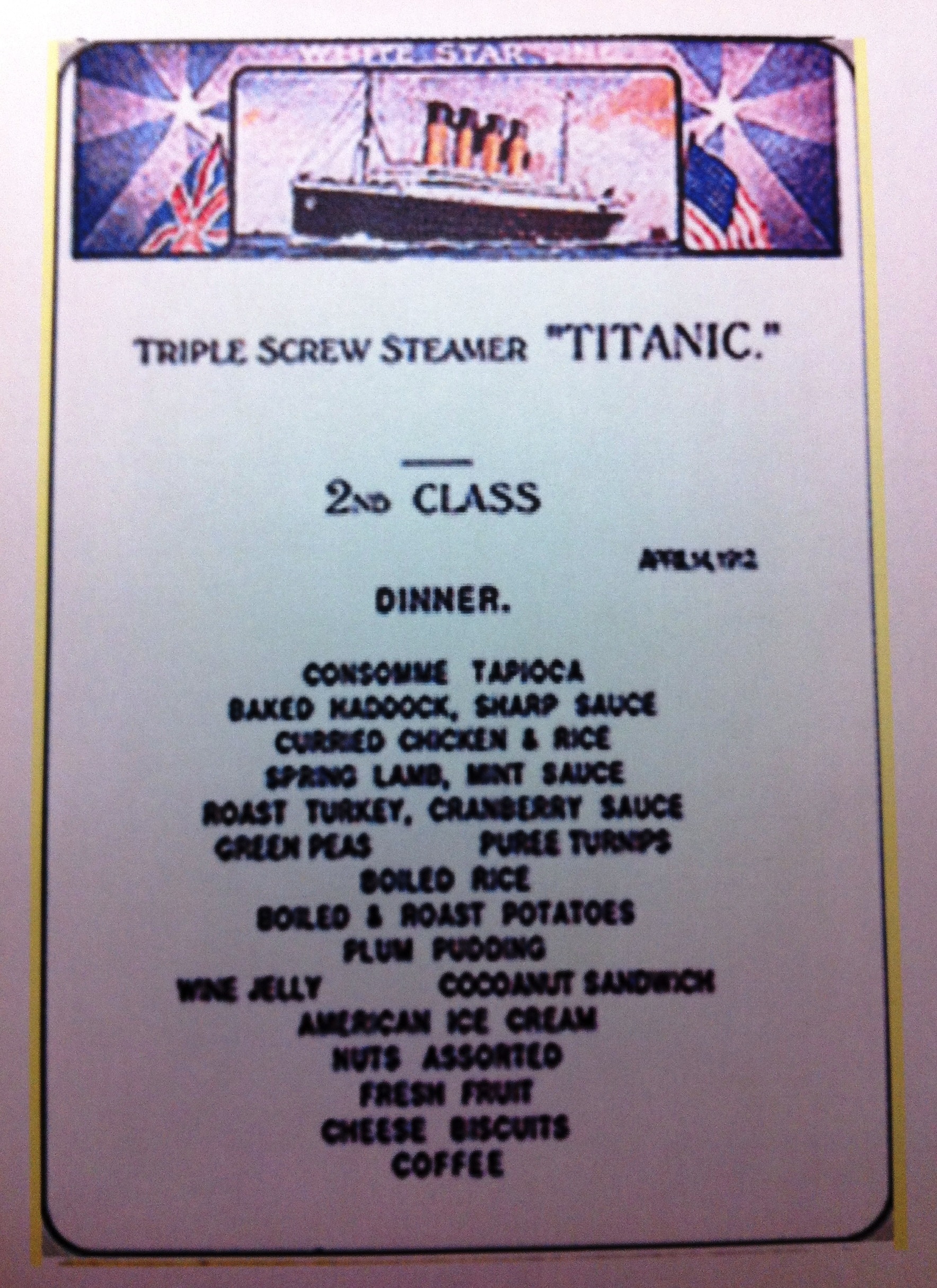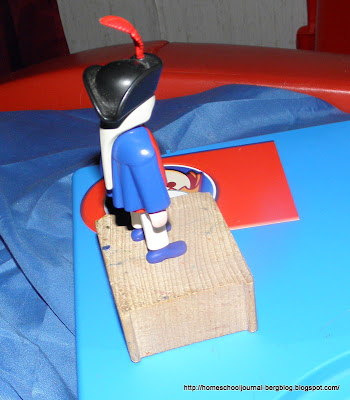A Night to Remember
We are studying the disasters near the turn of the century (1900, that is) and since it was the 100th anniversary of the sinking of the Titanic, we thought we would focus our studies there.
 |
| Model of the Titanic a student built and painted. |
An interesting activity to start off the study might be to measure the length of the Titanic -888 feet.


Large fruit displays with fresh fruit were also popular, although not especially practical for our dinner. We settled for a more sedate presentation.
So, with no further ado, here is the official
Second Class Dinner Menu.

We decided that even the second class meal was a bit too much for us to make in its entirety. We left out the Curried Chicken and Rice and Spring Lamb with Mint Sauce, Pureed Turnips, Plum Pudding, Wine Jelly, and Cocoanut Sandwiches, but if you want to add these to your menu, you can find the recipes here.
Titanic Second Class Dinner Menu, Bergenholtz Style
First Course ~ Soup
First Course ~ Soup
Consomme
Second Course ~ Main Dishes
Roasted Turkey with Cranberry Sauce
Green Peas
Boiled Rice
Roasted Potatoes
Third Course ~ Desserts
American Ice Cream ~ Vanilla
After Dinner
Cheese and Biscuits
Fresh Fruit
Tea or Coffee

Here is a brief clip of the music, to give you an idea of what it was like.
And, here is a narration of
The Story of the Titanic
by a student.
(These are his words exactly.)
This is you.
Or, if you are a boy, and you are a bit sensitive, this is you.
This is the dinner on the Titanic and you are eating it.
You notice that someone else comes in.
You notice that someone was manning the controls at the station.
You hear a whole bunch of people saying, "An iceburg! Ahhhh! We are going to crash into it!"
Then you scramble up to the viewing platform and you see it!
And you came to it! You saw the last glimpse of the floating Titanic.
CRASH! It hit the iceberg!
A whole bunch of people, including yourself, scramble for a lifeboat, and the band played, and played, and played, even though it was sinking.
You and your friends finally found lifeboats.
And the band is still playing.
27th President
Served: 1909-1913
Party: Republican
Income taxes collection became part of the 16th amendment to the Constitution
First President buried at Arlington National Cemetery
7th inning stretch: owed to Taft: during the 7th inning of a game, he stood up to stretch and everyone else followed
Other disasters around the turn of the century...
Great Chicago Fire, October 8-9, 1871
Due to dry conditions and a city primarily made out of wood, a rogue-fire, believed to have started in a barn, swept through the city, taking 300 lives and leaving 90,000 of Chicago’s 500,000 residents homeless.
| source |
Johnstown Pennsylvania Flood, on May 31, 1889
 Johnstown, with 30,000 inhabitants, was inundated with floodwaters from a broken dam in 10 minutes. In less than an hour after the dam gave way, entire families were lost and tens of thousands were left homeless. Lower areas of the city were covered by over 20 feet of standing water polluted by debris from 14 miles of countryside and remnants of local settlements. The American Red Cross arrived in Johnstown soon after the dam collapse. Clara Barton directed the establishment of shelters; distribution of clothing, food, and medical supplies; and organized local relief committees. The Red Cross constructed a warehouse, three shelters, and an infirmary complex, as well as assisted with the city's rebuilding efforts. After five months, at the close of the Red Cross operations, these buildings were dismantled. Some lumber was sent to Washington, D.C. where Barton intended to build the Red Cross Headquarters. The rebuilding of Johnstown lasted five years. We enjoyed reading The Terriable Wave. Although the characters in the book are fictional, they are based on personal accounts from the actual event.
Johnstown, with 30,000 inhabitants, was inundated with floodwaters from a broken dam in 10 minutes. In less than an hour after the dam gave way, entire families were lost and tens of thousands were left homeless. Lower areas of the city were covered by over 20 feet of standing water polluted by debris from 14 miles of countryside and remnants of local settlements. The American Red Cross arrived in Johnstown soon after the dam collapse. Clara Barton directed the establishment of shelters; distribution of clothing, food, and medical supplies; and organized local relief committees. The Red Cross constructed a warehouse, three shelters, and an infirmary complex, as well as assisted with the city's rebuilding efforts. After five months, at the close of the Red Cross operations, these buildings were dismantled. Some lumber was sent to Washington, D.C. where Barton intended to build the Red Cross Headquarters. The rebuilding of Johnstown lasted five years. We enjoyed reading The Terriable Wave. Although the characters in the book are fictional, they are based on personal accounts from the actual event.Johnstown Flood National Memorial preserves the ruins of the South Fork Dam, part of the old lakebed, and some of the buildings of the South Fork Fishing and Hunting Club. They have a Junior Ranger program with a booklet you can download and printout before you go. The park visitor center is open 7 days a week 9 am to 5 pm all year-round. We are closed on Federal winter holidays. The historic 1889 Clubhouse has no heat. It is open in the summer only and staffed by volunteers. The park grounds are open from sunrise to sunset. $4 per person for visits of 1-7 (consecutive) Days Children 15 and under admitted free 2013
FEE FREE DATES:
April 22-26-National Park Week (That's right, no fees the entire week!)
August 25-National Park Service Birthday
September 28-National Public Lands Day.
November 9-11-Veteran's Day Weekend.
I thought for sure Joan of Our School at Home wrote a post on a field trip to the Johnstown Flood area but I couldn't find it.


San Francisco Earthquake, April 1906
At 5:13 a.m. on April 18th, the city of San Francisco, California, was struck by a tremendous earthquake, further being destroyed by a great fire that raged for four days. Felt for an area of about 375,000 square miles, the death toll was said to be more than 3,000, with losses estimated at $500,000,000.We read these books, which were packed with a lot of information.
Why study the disasters?
How do they affect us today?
After the Titanic disaster, recommendations were made by both the British and American Boards of Inquiry stating, in part, that ships would carry enough lifeboats for those aboard, mandated lifeboat drills would be implemented, lifeboat inspections would be conducted, etc. Many of these recommendations were incorporated into the International Convention for the Safety of Life at Sea passed in 1914. Also, United States government passed the Radio Act of 1912. These acts stated that radio communications on passenger ships would be operated 24 hours along with a secondary power supply, so as not to miss distress calls. The International Ice Patrol, an agency of the United States Coast Guard that to the present day monitors and reports on the location of North Atlantic Ocean icebergs that could pose a threat to transatlantic sea traffic was also formed. Also, following the Titanic disaster, ships were refitted for increased safety. For example, the double bottoms of many existing ships, including the RMS Olympic. were extended up the sides of their hulls, their waterlines, to give them double hulls. Another refit that many ships underwent were changes to the height of the bulkheads. The bulkheads on Titanic extended 10 feet (3 m) above the waterline. After the Titanic sank, the bulkheads on other ships were extended higher to make the compartments fully watertight.
Because of the Great Chicago Fire, October 8-9, 1871, we now have an annual Fire Prevention week. The first Fire Prevention Day was proclaimed by President Woodrow Wilson on October 9, 1911, the 40th anniversary of the Chicago blaze. Since 1922, Fire Prevention Week has been observed on the Sunday through Saturday period in which October 9 falls.
The Johnstown Flood established the American Red Cross as the pre-eminent emergency relief organization in the United States. Starting in August 1938, continuing for the next five years, the U. S. Army Corps of Engineers gouged widened, deepened, and realigned about 9 miles of channel in the city, and encased the river banks in concrete and reinforced steel. Johnstown proclaimed itself "flood-free," a feeling reinforced when Johnstown was virtually the only riverside city in Pennsylvania not to flood during Hurricane Agnes in 1972.
As damaging as the San Francisco Earthquake and its aftershocks were, the fires that burned out of control afterward were even more destructive. It has been estimated that up to 90% of the total destruction was the result of the subsequent fires. This gave impetus to construction of the largest high-pressure water distribution network ever built—San Francisco’s Auxiliary Water Supply System (AWSS). Building codes have been improved since this time to help the buildings to remain standing after earthquakes.
inspiration and sources:















